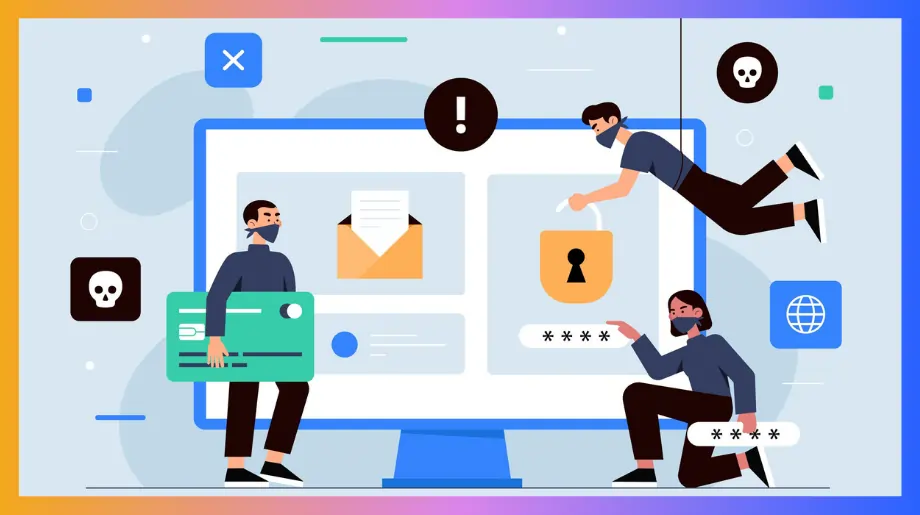Setting up multi-factor authentication (MFA) for your company? You'll see two crucial words: "enabled" and "enforced." Many IT pros get confused by these terms. But knowing the mfa enabled vs enforced difference isn't just about words. It's about making wise security choices that stop cyber attacks.
Many companies think they're safe after setting up MFA. But they're wrong. They leave big security holes open. The difference between "enabled" and "enforced" can decide if your company stays safe or gets hacked.
This guide shows you everything about these two MFA states. You'll learn how to make the right choices for your security setup. No more guessing. No more gaps in protection.
MFA Enabled vs Enforced: A Detailed Overview
What is Multi-Factor Authentication?
Why does your bank ask for your password AND send a code to your phone? That's multi-factor authentication at work. It's your security system that verifies multiple credentials before allowing anyone access to your accounts.
- Passwords alone are like using a single lock on your front door. Smart, but not smart enough. Hackers love cracking passwords because once they're in, game over. MFA changes the rules completely.
- When you activate multi-factor authentication in cybersecurity, you're building multiple security checkpoints. Each layer makes it exponentially harder for hackers to break in.
- Modern MFA has evolved beyond those clunky SMS codes. Think instant push notifications, seamless biometric scans, and intelligent systems that know when something feels off about your login.
What is MFA Enabled?
Your company decides everyone needs MFA protection. They have enabled it for your account, but here's the twist: you haven't yet completed the setup process. What is mfa enabled mean?
The feature is turned on, but you're still in the setup phase.
When you try to log in, the system says, "Hey, you should set up MFA now!" However, it then provides a skip button. You can still access your accounts using your old password while the system waits for you to complete registration.
Still Using Passwords Only: Even though MFA is "enabled," you can bypass it entirely and log in the old-fashioned way until you complete the whole setup process.
- Postponement Option: Busy day? No problem. You can delay the MFA setup and address it later, while still accessing all the necessary resources for work.
- Legacy Apps Work Fine: Your older applications and desktop tools continue to work exactly as before, without requiring any additional authentication steps or changes.
What is MFA Enforced?
MFA enforced means you've completed the process. You have completed the setup process and registered your authentication methods. Now, the system requires you to use multiple factors every time you log in. No more skipping, no more delays.
- Password-Only Access Blocked: The system completely blocks traditional password-only logins for modern authentication scenarios. Your stolen password becomes useless to hackers without your second factor.
- App Passwords Required: Legacy applications that don't support modern authentication will need special app passwords instead of your regular password for secure access.
- Automatic Transition: Once you complete MFA registration, the system automatically transitions you from enabled to enforced status without requiring any additional steps.
MFA Enabled vs Enforced: A Detailed Comparison
User Enrollment Behavior
Here's where the difference between enabled and enforced MFA shows up clearly. When MFA is enabled, you get those "Please set up MFA" pop-ups during login.
- People Keep Skipping: Users postpone MFA setup for months, leaving their accounts wide open to password-based attacks the entire time
- Finding Workarounds: Smart users discover they can use older apps or different browsers to avoid MFA setup requirements altogether
- IT Keeps Chasing: Your IT team wastes time sending reminders and conducting training sessions to get people to complete the setup process
- Complete Protection: With enforced MFA, every user gets immediate security without exceptions, while stolen passwords become worthless since attackers need physical access to phones or biometric data
Enforced MFA eliminates security gaps while reducing administrative overhead for your technology team.
Authentication Coverage
Enabled MFA creates gaps in your security coverage. Your email might ask for MFA, while your file sharing doesn't. This flexible approach helps users maintain productivity during busy periods.
- Mixed App Requirements: Different applications have varying MFA rules. Users get protection in some areas while maintaining quick access in others.
- System Compatibility: Automated processes and API connections continue using basic passwords. This keeps existing workflows running smoothly.
Enforced MFA provides complete coverage across all systems. Every access point gets the same strong protection. Users know exactly what to expect from every login.
- Universal Protection: Every application follows the same security rules. No confusion about where MFA is needed.
- Complete Coverage: All access points get maximum protection. Hackers find no weak spots to exploit.
Security Risk Exposure
The difference between enabled and enforced MFA is huge when it comes to actual protection. Enabled MFA allows flexible access but keeps some risks. Enforced MFA locks down everything completely.
With Enabled MFA - Risk Flexibility:
- Password Breaches Remain Risky: When other websites get hacked and passwords leak, attackers can still use those passwords. But users can complete MFA setup when they're ready.
- Internal Threats: Malicious insiders can target password-only accounts. But good employees get time to adapt to new security without pressure.
With Enforced MFA - Complete Protection:
- Stolen Passwords Become Worthless: Hackers need your phone or fingerprint too. They can't get these from data breaches.
- Zero Internal Bypass: No employee can access systems with just passwords. Everyone gets the same strong protection.
Administrative Control
Your IT team's job changes entirely based on whether MFA is enabled or enforced. The difference between enabled and enforced mfa determines if your IT people spend time fixing problems or preventing them.
With Enabled MFA - Flexible Team Management: Enabled MFA gives your IT team flexibility to manage rollouts. This approach spreads the workload and allows personalized support.
- Answering Help Questions: Employees call IT for help setting up MFA. This creates personal connections and helps IT understand user needs better.
- Managing Individual Needs: Some employees need special consideration for MFA setup. IT can work with them to find solutions that fit their work style.
With Enforced MFA - Streamlined Operations: With enforced MFA, IT stops chasing people and starts maintaining systems. Everyone already has MFA working, so IT focuses on keeping it running smoothly.
- Automated Protection: Systems handle MFA requirements automatically. IT focuses on improving security instead of convincing users.
- Proactive Security: IT prevents problems before they happen. Time goes toward building better security instead of fixing user issues.
Audit & Compliance Impact
When auditors visit your company, they want to see how MFA protects your systems. Both enabled and enforced MFA have different compliance advantages.
With Enabled MFA - Flexible Compliance:
- Gradual Implementation: You can show auditors your rollout plan. This demonstrates commitment to security while allowing time for proper setup.
- Documentation Progress: You track enrollment rates and improvement over time. This shows continuous security enhancement efforts.
With Enforced MFA - Complete Compliance:
- Universal Protection: Every single account uses MFA. Auditors see 100% coverage without any exceptions to explain.
- Simple Reporting: No complex tracking needed. Everyone has protection, making compliance reports straightforward.
Why 'Enabled' MFA Alone Is Not Enough
Enabled MFA gives you a false sense of security. Your company dashboard shows "MFA Enabled" for all users. But many employees still log in with just their passwords. This means attackers can succeed using traditional methods.
- Password Attacks Continue: Traditional attack methods, such as credential stuffing and password spraying, remain effective. Password-only access still works for unregistered users.
- Security Theater: Management believes the organization is protected. Actual vulnerabilities remain unchanged. This creates dangerous blind spots in risk assessment.
- Attacker Intelligence: Cybercriminals research which organizations use enabled versus enforced MFA. They specifically target companies with incomplete implementations.
- Network Compromise: A single successful password-based login grants attackers initial access. This enables them to expand their reach throughout your infrastructure systematically.
Enabled MFA maintains existing vulnerabilities while creating administrative overhead. Only enforcement eliminates password-based attack vectors and provides measurable security improvements for your organization.
When to Choose Enabled vs Enforced MFA
Most companies should skip enabling MFA and proceed directly to enforce MFA. But sometimes you need to start with it enabled for practical reasons. The goal is always to reach enforced status as quickly as possible.
- Big Company Rollouts: Large organizations first avoid overwhelming their help desk with thousands of setup calls on the same day.
- Old Software Issues: Some legacy business applications require updates to work with modern authentication, necessitating a temporarily enabled status during upgrades.
- Employee Training Needs: Departments with non-technical staff may require additional time and training before enforcement becomes mandatory without compromising productivity.
- Executive Approval: Obtaining leadership buy-in for immediate enforcement may require demonstrating success with voluntary adoption first to reduce resistance.
For executives, IT administrators, and anyone accessing sensitive data, enforce MFA immediately. These high-value accounts cannot afford to remain in an enabled status, where they are vulnerable to attacks.
Enforce MFA for Real Protection
When you enforce MFA, you get absolute security. No more worrying about employee setup delays. No more gaps where hackers sneak in with stolen passwords. Everyone must use MFA to access everything.
Enforced MFA shuts down password attacks completely. When hackers buy stolen passwords from the dark web, they fail on your systems.
Infisign stands out as a complete cloud-based MFA solution that works with both on-premises legacy apps and cloud-native applications. Unlike other tools, it comes with directory sync and passkey authentication at no additional cost.
Key Benefits for Your Organization:
- Adaptive MFA: Dynamically adjusts security based on user behavior and risk levels, providing flexible protection with minimal friction
- Universal SSO: Users access multiple applications with single login while maintaining high security across all platforms
- Zero-Trust Architecture: Requires continuous verification for all users and devices, ensuring security is never assumed.
- 6000+ Integrations: Easy connectivity with various cloud and on-premises applications through comprehensive API support
- Automated User Management: Automates provisioning and deprovisioning of user access, maintaining security controls efficiently
- Windows Integration: Supports existing Windows authentication, allowing smooth access across enterprise environments
- Privileged Access Control: Governs access to sensitive systems with strict policies for high-risk actions
Ready to eliminate security gaps? Start your free trial with Infisign and experience enterprise-grade MFA that actually works for your business.
FAQs
What is the difference between enforce and enable MFA?
The primary difference lies in the level of security provided. Enabled MFA allows users to access systems with just their passwords while encouraging them to set up additional authentication factors. Enforced MFA requires users to provide multiple authentication factors for every access attempt, providing absolute security protection.
Does enabling security defaults enforce MFA?
Security defaults are Microsoft's basic security package. It forces admins to use MFA but treats regular employees differently. Normal users only need MFA when Microsoft thinks their login looks suspicious.
If you log in from your usual computer, you might skip MFA. However, from a coffee shop or a new device, Microsoft requires you to use MFA.
- Admins Always Need MFA: Administrator accounts must use multi-factor authentication every time, with no exceptions.
- Regular Users Sometimes Skip: Normal employees can use just passwords when Microsoft considers access patterns safe.
- Location Triggers: Unusual places or devices require MFA, but familiar locations might not need verification.
- Mixed Protection: Some people consistently use MFA, while others rarely do, resulting in uneven coverage.
Security defaults give partial protection, not complete protection. The mfa enabled vs enforced lesson applies - partial protection leaves gaps.





.webp)
















